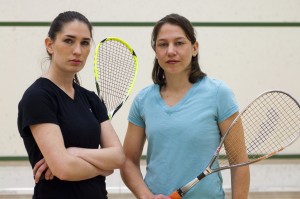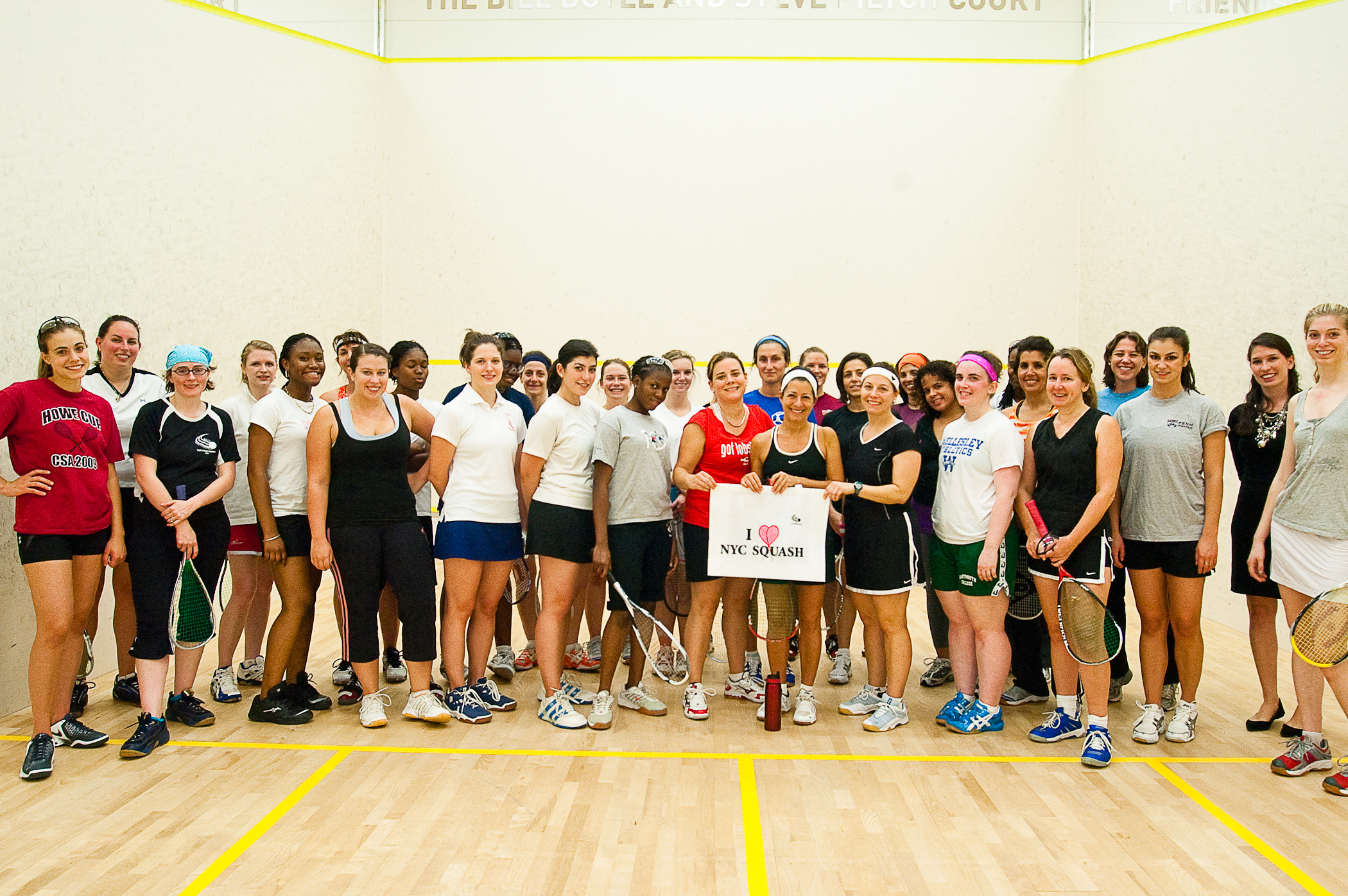By Jennifer Gabler
Squash Magazine is traveling around the country, focusing on how women build squash communities in their cities. For our first article of the new season, I started close to home and visited Jessica Green and Emily Stieff, the regional representatives to US Squash’s Women’s Committee and board members of New York’s Metropolitan Squash Racquets Association (soon to be renamed New York Squash). This dynamic pair has made New York into a model for women’s squash, and strengthened the squash community in general, with a record-breaking league, wait-listed tournaments, and the city’s courts filled with players of all levels.
From 24 female league players to over 125, in just three years
Jessica and Emily met on the squash courts in New York City in 2006. Fast friends, they competed in tournaments and league, but found themselves facing the same women — including each other — over and over again in competition. Sometimes they had to play in men’s draws when there were no women’s draws available. “That did not seem right to me,” says Jessica “I knew there had to be more women squash players in the biggest city in the country! And so I joined the MSRA/NY Squash Board of Governors, mostly to find more women to compete against.” Emily came along with her and over the summer of 2007, with the MSRA/NY Squash encouragement and backing, they got to work on a strategy to involve more women in New York squash.

In the past three years, they’ve had a huge impact. During the 2005-2006 season there were only four women’s league teams, with approximately 24 players total in a combined B/C division. This past 2009-2010 season there were 12 women’s teams with over 125 players across A and B/C divisions. This spike in players has allowed the MSRA to claim the largest league in the country (and perhaps the world) with 700 players competing on 74 teams across eight skill levels.
Tournaments in New York have also seen significant growth due to Emily and Jessica’s efforts. In addition to several small events, the MSRA/NY Squash runs two major tournaments each season: the Grand Open in January and the Hyder Trophy in May, both of which have seen increased numbers in recent years. In 2007 the Hyder had 141 players; it now draws nearly 200 players. Emily notes that these are “especially high numbers for a tournament run when most players are thinking of hanging up their racquets for the summer.” Female participation in tournaments is driving that growth in tournament participation; the 2010 saw record-breaking participation by women, with nearly 60 women filling up 3.0, 3.5, 4.0, 4.5, 5.0 and 5.5 skill levels draws.
How did they do it?
It’s no coincidence that Emily and Jessica both have a background in marketing and communications. Emily is a design associate in visual branding of consumer products, and Jessica is a marketing program manager in the travel industry. They have utilized their skills and passion to grow women’s squash participation in New York City. Through informal focus groups, membership surveys, and a lot of trial-and-error, they have been able to identify the reasons why women were not playing, fix those problems, and get the word out to players. This approach has carried over to the way the MSRA does business in general, helping to boost overall participation across all skill levels, for both men and women.
What’s next?
Although the number of women players has shot up in the last few years, female players only account for 21% of total MSRA/NY Squash membership. Emily and Jessica have made it their goal to grow that number to be at least one-third of total membership. “We’ve made great progress in the middle skill levels,” Jessica says, and “next year we plan on growing women’s participation from the low and high ends, with events for novice and elite players.” Emily agrees that beginners squash is a big opportunity to grow the sport, and notes that the MSRA/NY Squash is starting to run beginners clinics, to “get people who have always wanted to play on court with a pro to learn the sport.”
In addition, Jessica and Emily want to get more women involved in running the MSRA/NY Squash (see tip #6) and have added several new female board members this year. The new energy and enthusiasm will bring even more players to New York’s courts, and sustain the growth in women’s squash.

Emily and Jessica’s Top 10 Ways to Reinvigorate Women’s Squash in Your City
- Start casual: When we joined the MSRA/NY Squash board in 2007, our first initiative was to host an informal Women’s Squash Night. We advertised like crazy with posters at every club around the city, personal outreach to teaching pros, and emails to our entire membership. That first year we brought in 60 players, half of whom had never participated in MSRA/NY Squash events. Women’s Squash Night has become an annual event to kick off the squash season. We make it fun and focused on the social aspect. Players do get on court, but the key attractions are that women can reconnect after taking off for the summer, build their league teams, and meet new players for casual matches.
- Establish contact: Make it easy for players to find you. Create a unique, easy-to-remember email for women; we are WomensSquash@msra.net (if you want to contact us!). You might even make simple business cards to hand out when you meet new players. Make every aspect of participation as easy as possible, down to contacting you with questions.
- Vary the events: Three-day full-weekend tournaments are a big commitment — especially for women, many of whom have families. If this is the only women’s event you are running, you are missing out on an entire demographic of players. To reach a wider range of players, try a casual women’s round robin on a weekday evening, a Rules & Refereeing clinic with a teaching pro on a weekend afternoon, or an all-day Saturday structured box tournament. Consider doing some mixed events as well; for example, a Women’s 4.0/Men’s 3.5 round robin, followed by cocktails.
- Get out there: Be THE face of women’s squash for your city. Be present at all of your events and be sure to introduce yourself to women’s players every chance you get; soon you’ll become the go-to for women’s squash. Knowing the majority of players makes it easier to organize tournament draws and get players to sign up for your events, especially when those events come with your endorsement. Keep your eye out for new women at your club and make sure teaching pros know who you are and refer new players to you.
- Keep women in the know: Each time you run an event, collect players’ contact information. Make this into your distribution list and send regular emails about upcoming events specifically of interest to female players even if they’re not official members of your local Squash Racquets Association (SRA). Include in the email your association’s events as well as local club events, women’s pro tournaments, and even amateur tournaments in other cities. Keep your SRA’s website up-to-date, and use social media like Facebook, Twitter, or a blog to communicate with players. Check out our efforts at msra.net.
- Involve players: You shouldn’t be the only one running and promoting events. To make it a sustainable effort, encourage other women to run small squash activities like round robins with your help and guidance. Make a list of best practices you have learned, or share an event checklist with them so that they too can succeed. Be sure to promote their events through your SRA’s communications and website. Also use key players to help champion your events. For example, if you need more 5.0 women to fill a tournament draw, ask league captains and active 5.0 players who have already signed up to reach out to their friends.
- Remember college players. Every year squash players graduate and move to your city. Accustomed to a structured squash program, they may not know about local SRAs and how to get involved. So reach out to college coaches to introduce yourself and your program, and ask them to refer their players to you to continue playing. And don’t forget, many students will be home over holidays and the summer, so be sure to invite them to events even if they aren’t members of your SRA. They will be soon.
- Don’t forget about men either: Women like to socialize with men and the squash courts happen to be a great place to meet guys! Hold mixed playing events with men and women of comparable skill levels followed by a happy hour. This is also a great way to get women more comfortable with the idea of playing against men.
- Make it easy: Make it as simple as possible for players to find out about your events. We’ve found that the key to getting big turnouts is through smart marketing: all of the details of MSRA/NY Squash events — rules, schedule, venue details — are posted online, well in advance of the event. It’s especially important to enable online signups since it’s a hassle for players to print out a form and mail in a check. Invest in an online signup system and electronic credit card payment: you’ll get much higher participation numbers, and it will be easier for the tournament organizers to process entries. In addition, post the names of signups online with a cut-off number for each draw. This adds a sense of urgency and as a result the MSRA/NY Squash often has waiting lists for tournaments.
- Have fun! Don’t stress — if you’re not having fun, the players probably aren’t either. So accomplish what you can and don’t be afraid to ask the women’s players and the local club pros to help you. Players will appreciate all you are doing and want women’s squash to be a success too. Not every squash event has to be highly competitive and structured; it’s also OK to just get out on the courts and have fun, meet new people and get everyone excited about playing.


